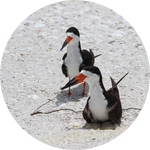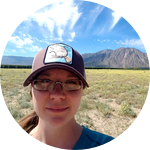About This Project
Many animals, including humans, accidentally eat plastic, but we don't yet understand the impacts of it from either a health or a behavioral perspective. Here, I am studying the diets of seabirds where the amount of plastic in their stomachs is compared to more natural components that they feed on within marine food webs. This will help us better understand whether birds that eat a lot of plastic do so at the expense of more typical food items, shedding light on their behavioral ecology.
Ask the Scientists
Join The DiscussionWhat is the context of this research?
Plastic pollution is a huge problem and has been found everywhere we have looked for it. Despite reports of wildlife eating plastic for over 50 years, we still don't understand how it impacts animal populations. Are seabirds eating plastic because we are out-competing with them for fish? It can be hard to link consumed plastics & wildlife health for ethical reasons, so here, I am use birds that died in fishing lines to learn how eating plastics impacts seabirds. An animal's diet impacts its condition, health, & reproductive success. By learning about the role that plastic pollution plays on seabird feeding ecology, we will help to fill a major gap in our understanding of the impacts of plastics on wildlife.
What is the significance of this project?
Plastic pollution occurs in all ecosystems, wildlife, and our own diets! Knowing more about the incidence & abundance of plastics in food webs can help us conserve seabird populations, 90% of which are in decline. While we still are unclear about the specific health impacts of consumed plastics, we know that many compounds in plastics are disruptive to the endocrine system, that is involved in hormone regulation & reproductive success. In this way, funding plastics trophic ecology research will help us to conserve threatened and endangered species & learn about the likely health impacts these contaminants can have on human populations.
What are the goals of the project?
We will compare the abundance and types of plastics consumed by seabirds of various locations and assess the overall condition (health) of those birds. As we work up seabird specimens, we look through all of the major organ systems, including those associated with contaminant filtration (liver and spleen) and those that are involved in reproduction (gonads) & can link their condition and weight to the health of that animal. By comparing these metrics with the plastics data, we can better understand the links between plastic consumption and the health and reproductive ability of wildlife that consume them.
Budget
This research is part of a larger, ongoing project and it is critical for the success of my new research program as a young faculy member. There is almost NO money out there for small projects like this, so we really need your help! Our study subjects are housed in freezers across the country and it costs a lot to ship them here. The supplies needed for our assessments (dissecting tools, microscopes, storage containers) need replacement, and students should not have to volunteer to learn these techniques - we should hire them and pay them a good wage! Let's support the fields of ecological research and wildlife conservation by developing the workforce that can help us solve environmental problems for which we are only now learning the extent of their severity. Plastic pollution is not something that will go away until we develop real solutions.
Endorsed by
 Project Timeline
Project Timeline
This project was placed on hold in 2020 as students were asked to leave our campus because of COVID-19 concerns. This Spring & Summer, we are in a whole different situation & we will bring & store more samples here. We are already training students on the techniques & by June, I expect 30 birds to be assessed for plastics & food web interactions. More birds will be assessed over summer, lead by interns. Final analyses will be completed by the end of the year.
Apr 02, 2021
Project Launched
Aug 20, 2021
Complete first 30 bird assessments
Sep 30, 2021
Finalize data assessments for first 30 birds
Dec 10, 2021
Complete second set of bird assessments
Jan 28, 2022
Finalize data assessments for all birds
Meet the Team
Team Bio
My team is comprised of 3 undergraduate researchers and one graduate student. Part of our goal is to understand the general health of wildlife and how parasites and plastics impact condition - so we have 1 student dedicated to bird necropsies. We also want to know how plastics impact biological interactions - so we have 2 students culturing organisms with plastic particles. As a team, it all fits together!
Kate L Sheehan
Hi! I'm an ecologist that studies the interactions between wildlife and their symbionts with an emphasis on parasitic worms that infect birds. I have assessed 87 avian species for general health, feeding interactions in local food webs, and parasitic infections.
I use techniques in community ecology to differentiate between groups of wildlife, and I do this with parasite community assemblage data. We have used parasites to link the feeding ecology of birds and their local prey (based on parasites as evidence) to define subspecies, sex, and age classes.
I also use landscape ecology to understand the impacts of human-induced alterations to ecosystems on the behaviors of wildlife and how parasites are destributed.
Finally, I document the incidence of plastic consumption in the wildlife that I study. Sometimes the hosts themselves have eaten plastics, but often it is their prey that consumed it or were entangled in it. This has spurred a whole new area of research in our lab and that is what my current campaign is seeking funding for.
Additional Information
As new faculty studying in a relatively new field, it is important to know that plastics ecology doesn't fit within traditional grant/funding mechanisms, so there are few to no opportunities for us to get financial support. So platforms like this can really help. What is more, many wildlife and conservation students are expected to perform voluntary internships while their peers in other disciplines are making money while they train. We should not expect our students to work for free and these funds will help me to provide compensation for time well spent learning how to perform complicated and detailed studies in ecology and conservation biology. BECOME A BACKER!
Project Backers
- 17Backers
- 41%Funded
- $1,541Total Donations
- $90.65Average Donation


